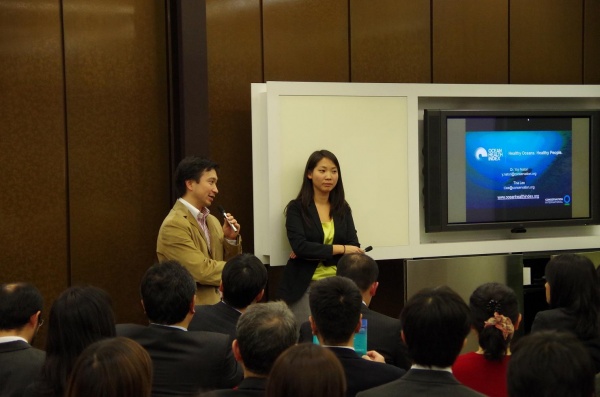A Global Assessment Tool to Measure Ocean Health
By: Tina Lee (Ocean Health Index Coordinator, Conservation International)
On 7 February 2013, Conservation International Japan and the Ocean Health Index team organized a Public Seminar at the World Bank Public Information Center in Tokyo, Japan on the Ocean Health Index, a new tool to measure the health of our human-ocean ecosystems.
The Ocean Health Index is the first assessment tool that scientifically compares and combines key elements from all dimensions of the ocean’s health – biological, physical, economic and social. The Index’s ten goals provide leaders with a portfolio of information that they need to develop and implement effective policies that promote ocean health.
More information about the Ocean Health Index can be found on the OHI website.
Upcoming Events
“The New Commons: Matching the Mis-Matches”
Date: 18 March 2013
Location: Yokohama, Japan
Suggested in the Japan Satoyama-Satoumi Assessment (2007-2010), the “new commons” is a potential key to the success of a more integrated and holistic approach to ecosystem management.
Further details and registration information
“Governing Satoyama-Satoumi Landscapes for Human Well-Being”
Date: 21 March 2013
Location: Kanazawa, Japan
The symposium will convene a variety of stakeholders including experts from Japan and abroad to discuss an innovative way towards sustainable use and management of satoyama and satoumi landscapes in Ishikawa.
Further details and registration information
International GIAHS Seminar Series Held in Ishikawa Pref.
By: Dr. Rizalita Rosalejos-Edpalina (Research Fellow, Kanazawa University)

Speakers and Participants in the Young Stakeholders Dialogue during the Second International GIAHS Seminar
Jutting off of Japan’s western coast, Noto Peninsula in Ishikawa Prefecture is home to mosaic landscapes and seascapes including secondary woodlands, grasslands, pastures, seashores, tidal flats and more. These diverse socio-ecological production areas are known as satoyama and satoumi. In recognition of the unique cultural and agricultural heritage of these areas, in June 2011, Noto’s Satoyama and Satoumi – along with Sado’s Satoyama (Niigata Prefecture) – was designated as Japan’s first Globally Important Agricultural Heritage Systems (GIAHS) site.
The GIAHS World Forum will be held in Ishikawa Prefecture in May 2013, and the Noto Satoyama Satoumi Project of Kanazawa University has been organizing the International GIAHS Seminar Series as a venue to stimulate public support and understanding on the value of GIAHS and to facilitate sharing of knowledge and experiences. To date, two International Seminars on GIAHS have taken place.
The First International Seminar, ‘The Role of International Frameworks toward Sustainable Development of Satoyama and Satoumi’ was convened in Kanazawa, Ishikawa on 14 January 2013. It aimed to disseminate information on GIAHS experiences in research, management and governance in designated GIAHS sites, including the Ifugao Rice Terraces in the Philippines, and Japan’s Noto and Sado. The seminar was attended by experts and practitioners from Germany, the Philippines, and Japan, as well as students, representatives of international organizations and other stakeholders.
From 19-20 February, the Second International GIAHS Seminar was held in Suzu City, Noto Peninsula featuring a keynote presentation by Dr. Parviz Koohafkan (GIAHS Global Coordinator) and a young stakeholders’ dialogue with presentations by six current and past participants in the Noto Satoyama-Satoumi Meister Project offered by Kanazawa University.
The structure of the two-day seminar was particularly effective at focusing both on global challenges and opportunities for socio-ecological production landscapes and seascapes, and specific discussion during the young stakeholders dialogue about the experiences of the young people who make their livelihoods from sustainable use of satoyama and satoumi. The lessons learned and shared by these young people spanned many disciplines including organic rice cultivation, charcoal production, and the cooking/culinary sector. While all the presenters had faced difficulties, as one rice farmer put it, “despite many challenges, I have lived happily with my family”.
Effective cooperation contributed to the seminar’s success, which was organized by the Noto Campus Project, Noto Satoyama Satoumi Meister Training Program housed at Kanazawa University, and co-organized by the United Nations University Institute of Advanced Studies Operating Unit Ishikawa/ Kanazawa.
For a full report on the presentations and discussions, please read more here.




